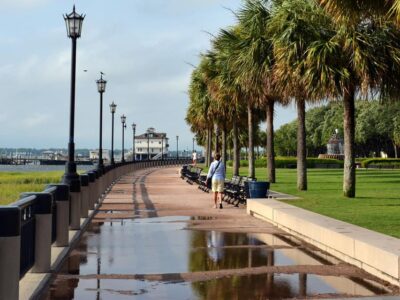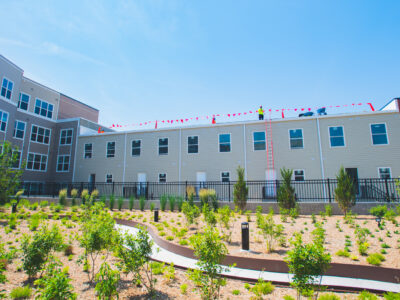(Bloomberg) —
No reasonable human has dared wade willingly into the brackish waters beside Baltimore’s National Aquarium for generations. Perched on a pair of piers extending into the city’s Inner Harbor, the facility is home to some 20,000 marine animals, swimming and slithering within a striking glass-crowned complex.
The urban environment outside its walls is less welcoming: The Jones Falls river, which feeds into Baltimore’s harbor, was a heavily polluted industrial waterway for most of the 20th century, and it still sweeps sewage, trash and toxic runoff into the downtown basin after every rainstorm.
But a new 10,000-square-foot (900-square-meter) habitat called Harbor Wetland aims to help bring back the aquatic life that once hummed in the Inner Harbor — and help make it safely swimmable for people, too. Designed by Baltimore-based architecture firm Ayers Saint Gross, the floating structure is among the largest and most ambitious efforts to clean up urban waterways by tapping the filtering properties of native shrubs and grasses.
Architects and aquarium staffers devised a novel pontoon technology to create an artificial version of the natural wetlands that once defined the region’s shoreline. Now a layered topography with varied planting surfaces, the $14 million project is already attracting mollusks, fish and seabirds, among other creatures. During operating hours, the wetland also functions as a free floating park, with an elevated walkway, seating and shade structures designed to lure land-bound visitors as well.
Jacqueline Bershad, the National Aquarium’s vice president of planning and design, describes the project as a means of addressing two important questions facing the institution, which has been a waterfront anchor since it opened in 1981. “How can we bring back a tiny piece of the Chesapeake Bay to the Inner Harbor,” she said, “and also bring people down to the water?”
There’s hope that the project can mark a fresh milestone in the ongoing recovery of Baltimore’s aquatic health. The Patapsco River, which forms the Inner Harbor, flows into the Chesapeake, the largest estuary in the US and a critical part of the region’s economic life. In 2002, the city of Baltimore entered into a consent decree with the Environmental Protection Agency and the Maryland Department of the Environment in order to fix persistent overflows from the city’s aging sewer system — a violation of the Clean Water Act — by 2016. Despite progress, the agreement has since been extended to 2030.
Today, nutrient-rich runoff in the harbor triggers algal blooms that deplete dissolved oxygen, creating “dead zones” that smother marine life. The National Aquarium has recorded levels of chlorophyll from an algae bloom in January 2020 as high as 670 micrograms per liter — 655 micrograms above a healthy level. It’s a problem the aquarium has been trying to address since it first installed a 200-square-foot floating wetland in 2010. As growing plants extend their roots into the water, they take up excess nutrients and contaminants like heavy metals.
Read More: A ‘Ghost River’ Is Unearthed in Baltimore
While such features are often deployed in stormwater retention ponds, the National Aquarium was among the first to attempt one for a brackish tidal system. “It was pretty innovative at the time,” said Amelle Schultz, principal at Ayers Saint Gross. “But there were essential flaws. As their biomass grew, they essentially sank under their own weight.”
Schultz and her team were brought on to create a waterfront master plan for the National Aquarium campus in 2016, working from an earlier concept by the Chicago-based Studio Gang. “We identified zones that would interpret different ecosystems of the Chesapeake Bay watershed: the coastal plain, Appalachian plateau and the salt marsh. The aquarium identified the salt marsh as the first project they wanted to implement,” said Schultz.
Ayers Saint Gross also took a crack at a new design for a floating wetland, and in 2017, a small prototype was installed in the harbor, incorporating a pontoon-mounted planting surface that could be adjusted for buoyancy as marshy plants grew atop it. Soon, killifish and blue crabs showed up, as well as the bigger creatures that eat them, like rockfish and cormorants. “It was very successful,” said Schultz. “It was the conceptual foundation of the expanded version.”
This larger human-made marsh took several months to construct and plant, bringing in elements like elevation changes and an aeration system. It’s expected to be a draw for Bay dwellers like oysters, which contribute their own water-filtering powers: The submerged portion of the site includes artificial reefs seeded with shells sourced from nearby seafood restaurants. The wetland is ribboned with a shallow channel that snakes through the grass, with a current powered by 35 airlifts — giant-sized versions of the bubblers in home fishtanks — pumping oxygen into the water.
The stream’s circulation mimics the tidal action in salt marshes, with one difference. “This only goes one way, but the animals don’t know that,” said Paul Valiquette, the aquarium’s director of exhibit fabrication and operations.
With years of experience with indoor habitats, Valiquette described the challenge of creating a fully outdoor exhibit as he worked with National Aquarium general curator Jack Cover in figuring out the wetland’s inner workings. The results, so far, seem encouraging: He pointed to the small schools of Atlantic silverside lurking in the shadows of the cordgrass and described how a wide range of species, from turtles to river otters (caught playing on the dock by aquarium security cameras), have found their way to the artificial wetland.
“It’s literally like an oasis,” said Bershad, who noted that original plans called for extending the structure further along the pier; future expansion may still be coming. The project also reflects the ongoing transformation of the National Aquarium itself, from a self-contained wildlife enclosure to one that provides public spaces to gather, for all kinds of species.
“We’re not putting animals in here,” she said. “We’re creating a place for them to come.”
Harbor Wetland’s sophistication and tidal features are unusual, but other cities are also experimenting with artificial shoreline features that are more flood-resistant and friendly to wildlife than concrete or steel seawalls.
In Boston, for example, a grassy floating island has been a feature of the Charles River for several years, and a team of researchers led by a Northeastern University scientist has proposed lining the waterfront in an “Emerald Tutu” of biomass modules that could both improve water quality and provide protection from storm surges, much like the coastal marshes that once encircled the city. Chicago’s Wild Mile, a floating eco park launched with the Shedd Aquarium and other local partners in 2017, consists of a series of floating mats of native plants growing in the heavily polluted Chicago River, serving as a filter while attracting marine life, including local celebrity snapping turtle Chonk.
Baltimore already has a marine celebrity, Mr. Trash Wheel. Residing a few piers away from the National Aquarium, the solar-powered refuse collector with googly eyes has been taking in trash since 2014, and he’s spawned a whole family of trash wheels. While runoff remains a problem, water quality in the Inner Harbor has improved as polluting industries gave way to office and residential towers. In June, the nonprofit Waterfront Partnership of Baltimore held a public swimming event in the harbor — once unthinkable, now often no riskier than other Bay beaches.
Baltimore’s relationship with its waterfront will evolve further as the city awaits the redevelopment of Harborplace, the “festival marketplace” that was once a shining example of 1980s-style urban waterfront renewal. In 2022, a local developer acquired the failing retail complex, located steps from the National Aquarium, and proposed replacing its pavilions with a mix of commercial and residential buildings; plans also include “softer” shorelines and new runoff retention facilities, with early renderings showing a floating park and a series of small landscaped islands.
Schultz said that there’s been a “sharing of knowledge” between the people developing Harborplace’s public spaces and the Harbor Wetland team. “But they’re two very distinct projects. The relationships are established, but very casual,” she added.
Already, however, Schultz noticed the impact her work was having on visitors. “I took my kids and my husband down there after dinner, because I wanted them to see what I’ve been spending all my time on. And I overheard a little girl tell her dad, ‘This is all about the Chesapeake Bay!’ She already knew what this project represents.”
Can it be replicated elsewhere? “Other waterfronts are going to have different ecosystems,” Schultz said, “but these basic principles of water conservation, connecting people to water and educating people on environmental issues and historical ecology can all transfer across locations.”
© 2024 Bloomberg L.P.





